Western European economy 800–1000
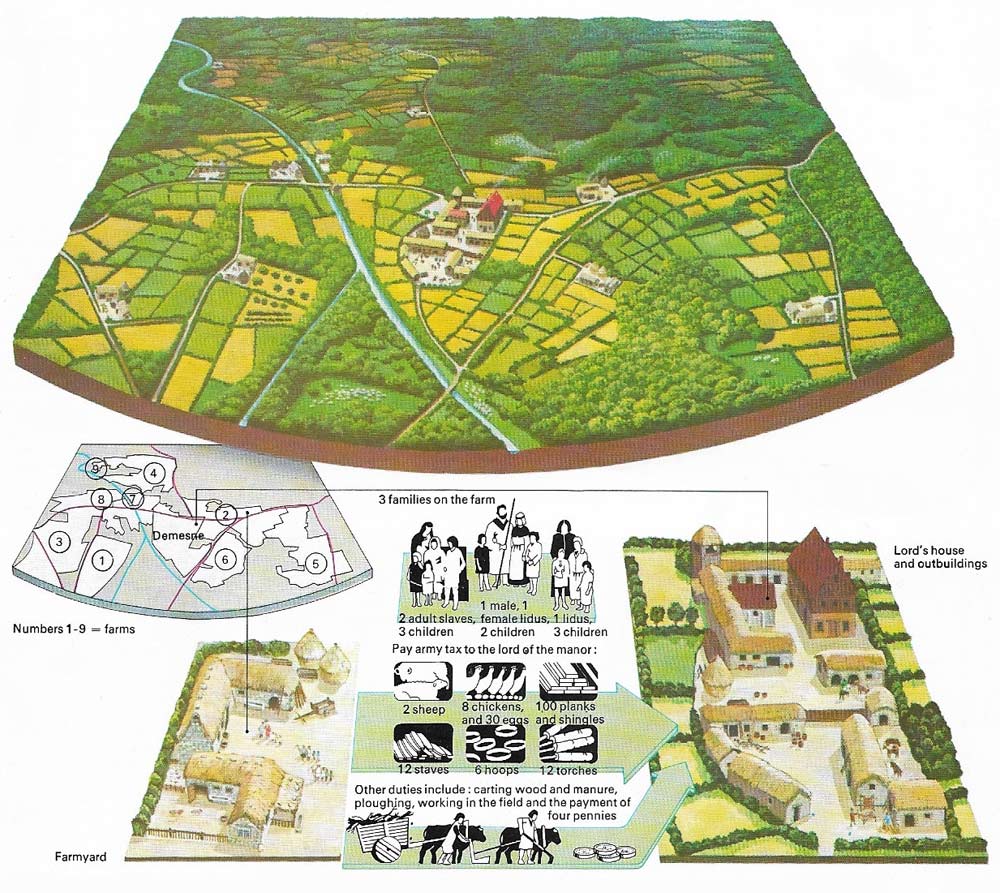
Figure 1. A typical "villa" or rural social unit in Carolingian Europe is here illustrated, and its population and composition shown. This organization was the result of the fusion of the old Roman "villa" with the customs of the invading German people. The status of the peasants varied: some were free, some owed various degrees and types of service to the lord. An estate was divided into the demesne land, the property of the landlord cultivated by forced labor, and the land cultivated by his tenants as "mansi". The return for their tenancy was calculated in various burdens of service. These could be increased if the tenant exchanged his military obligations for service to the lord. Carolingian peasants were divided into "coloni", free men still obliged to till their own land, "lidi", half-freemen owing certain legal obligations, and "servi" who had no legal rights at all. But although outside the law, "servi" did hold property. The total population of the estate was known as the "familia" and was supervised by the landlord or his agent. Slaves in principle worked the demesne land for three days a week, while "coloni" and "lidi" performed set tasks throughout the year. Estates such as the one illustrated were centralized units of production on land redeemed fro the surrounding forests. They were also early centers of rudimentary industrial organization for weaving and cloth-production. Finally, they were the basic unit of the rural feudal society that provided both the stability and the opportunity for oppression in early medieval society.
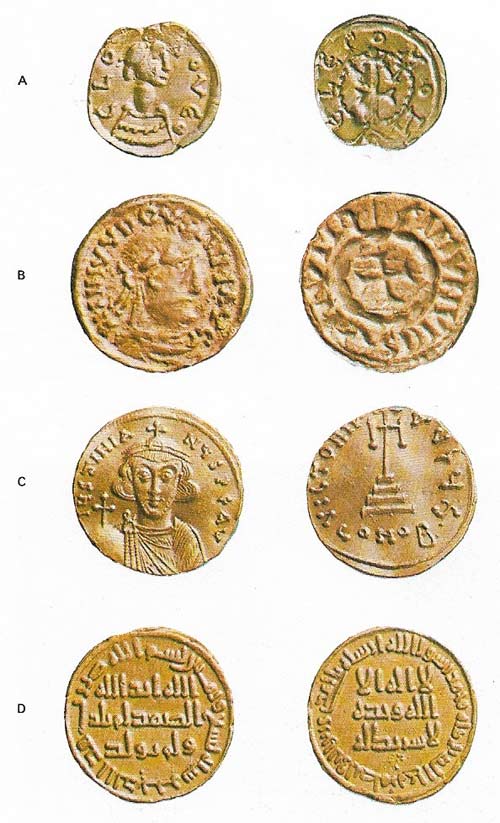
Figure 2. Medieval currency problems were twofold: to preserve a coinage acceptable to all trading partners and also to enable transactions to be performed through a monetary medium rather than by barter. The Clovis II coin (A) shows the Merovingian attempt to maintain a prestige form of Roman coinage, but debased both in design and metallic content. Coins such as the gold solidus (B) of Louis the Pious (778–840) were minted in many towns, although under the control of the king. No Western economic system at this time could support such reliable coinages as the Byzantine nomisma (C) of Justinian II or the Arab gold dinar (D). These coins were the basic tender of medieval international trade until the Florentine florin was minted in the 14th century.
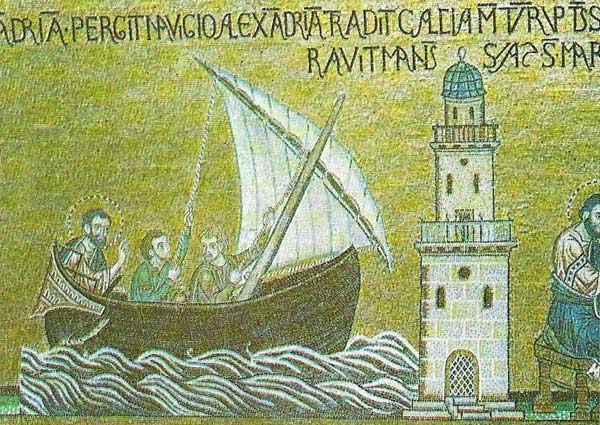
Figure 3. Trade in the Mediterranean was sharply curtailed by the pirates who followed in the wake of the Arab conquest. Yet gradually the need for raw materials from the West and for luxury goods and spices from the East ensured that increasing numbers of vessels, as this one portrayed in a Venetian mosaic, plied the Mediterranean.
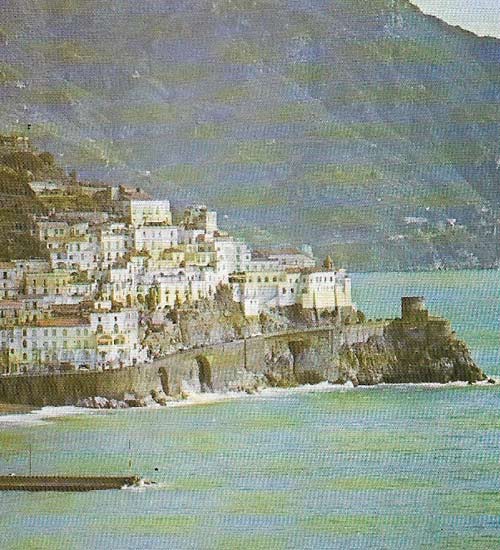
Figure 4. Amalfi, with its natural harbor, was one of the key commercial links between the Western world and Byzantium before the rise of Venice. The revival of western Mediterranean trade came from Italian towns such as Amalfi, Naples, Salerno, and Ravenna that had the closest links with the Byzantine world.
Western Europe in the 9th and 10th centuries was the poor relation of both the Arab and the Byzantine worlds. It was poor in the exploitation of its natural resources, in technical ability, in political cohesion and cultural achievement. Europe's social and economic backwardness was further threatened by Magyar hordes from the east and incessant raids by Vikings who swept southwards from the Scandinavian countries.
The growth of self-sufficiency
The temporary political unity and economic regulations of the Carolingians (Charlemagne and his successors) throw little light on actual conditions of life in the ninth century. Charlemagne attempted to stabilize and centralize the coinage throughout his empire, centred on France, to avoid exploitation in times of scarcity by regulating prices, to facilitate trade by keeping down internal customs dues and to introduce a universal system of weights and measures. But the regularity with which his instructions were issued indicates their ineffectiveness; the actual unit of production and consumption remained the great estate (Figure 1), a legacy of the Roman villa.
The economy of the Roman world in the invasion period was based on the great estates of the old landowning aristocracy. The decline of easy communications and trade forced these social units to become more self-sufficient. Alongside the estates, some of which passed into the hands of the invaders, there remained a free peasantry that still existed in the 9th century. But its decline was hastened by the centralization policies of Charlemagne and the obligations imposed by the government on all free men. It became preferable to surrender individual land rights to the local lord in order to escape the fiscal liabilities of freedom.
The Church, trade and commerce
The decline in personal freedom benefited the great estates of the aristocracy and the Church. Most available records of 9th-century estates are monastic and show a pat-tern of organized growth indicating that the Church played a crucial role in maintaining economic stability in difficult times.
The growth of European towns was based both on the old Roman cities (especially in Italy and the south) and on the garrisons and royal residences of the Carolingians and the Merovingians, their predecessors, such as Aachen, Nijmegen, Worms, Frankfurt and Ratisbon. Other cities, and mercantile suburbs of older cities such as Paris, grew round the monasteries which were the major producers of surplus goods for sale.
The uncertainty of statistics of trade and commerce after the fall of the Western Empire has given rise to much theorizing by historians. It fostered especially the belief that the economy of the Western world survived the Germanic invasions, but was brought to a halt by the Islamic conquests of the 7th century. The loss of the Mediterranean, it was argued, destroyed the movement of merchandise both between East and West and also internally within the West, reducing trade to mere barter. In fact trade continued, although on a much reduced scale. The centres of commerce initially switched from Provence and Languedoc to the north of Europe – Frisia, the Low Countries, northern France and the Rhineland. The old route to the north from Ostia (the port of Rome) to Provence and thence by land gave way to a land route over the Alps. Italian ports such as Amalfi (Figure 4) and Gaeta maintained a precarious commercial liaison with the East and in the tenth century the emergence of Venice (Figure 3) foreshadowed a new era in Mediterranean trade.
Charlemagne sought to create a stable coinage, but never succeeded in making the minting of money a royal monopoly which was one possible way of avoiding constant debasement. Charlemagne did understand the need for a coinage to be used as a medium of exchange, rather than barter, and his silver denarius, or penny, became one of the standard coins of the medieval West. But Carolingian coinage supplied only the small change of the West, whereas the international trading currency of the Middle Ages became the Byzantine gold nomisma and the Arab gold dinar (Figure 2).
The population of Western Europe expanded very slowly after the ravages of the invasion years. Stagnant economies could not support cities of 50,000 to 100,000 people such as those of the Arab world at Cairo, Antioch and in Spain at Cordoba. Under the manorial system, towns had lost their importance and many were abandoned.
Industry and agriculture
Industry, such as mining and weaving, was only in its infancy in the ninth century and was mainly centred on monastic properties. Comprehensive rotational systems of agriculture barely survived on the old Roman estates. Agricultural technology gradually improved with the introduction of heavy wheeled ploughs for northern soils. The harrow and the flail were probably introduced at that time and the decline of slavery made the extended use of watermills for grinding corn an economic necessity. Yet production was too low to support any great increase in population and trade was too ill-organized to offset local effects of crop failure and plague. The technological knowledge of the Romans was never wholly lost, however, and new inventions were gradually developed.
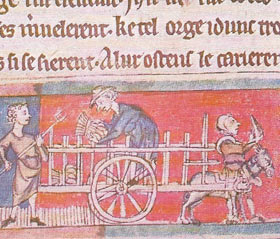 |
| Early medieval life was primarily agricultural. Harvest time was the crucial part of the year. Cereals were the staple of life, meat being a luxury. Limited productivity and trade meant that a successful harvest was the only insurance against famine and its constant attendant, plague. |
